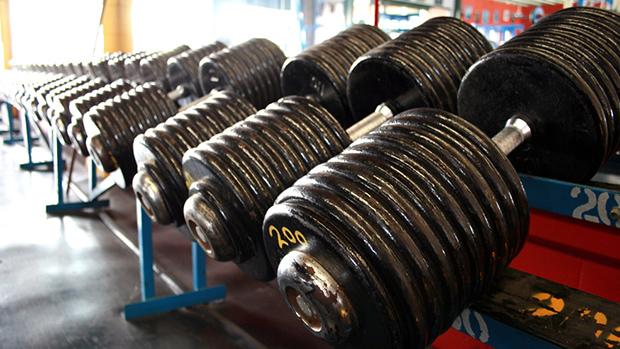I Want It All and I Want It Now!
I find myself deluged by individuals who want it all at the same time: they want to be muscular, very strong, and super explosive. When an elite athlete with an already decent amount of all these qualities comes up to me with those goals, the answer is quite simply: continue on the same path! However, when an individual with little training experience or little in the way of muscle size, strength or power comes up to me with the same request, the answer might be a little more complex.
How can an individual obviously requiring a significant amount of work in all three of these physical qualities reach his goal without overtraining? A method I've found to be quite effective is the pendulum approach. It's a simple yet effective way of planning your training to allow for maximum gains in all your desired capacities. Here's how it works:
 |
As you can see in the graphic, the basic principle of the pendulum approach is that you alternate between training objectives, and you do so very often with each "phase" generally lasting one week. In other words, in the basic pendulum illustrated you're:
• Training for structural gains (hypertrophy) for one week.
• Training for functional gains (limit strength) for one week.
• Training for functional gains (power) for one week.
• Training for functional gains (limit strength) for one week.
• Training for structural gains (hypertrophy) for one week.
That constitutes one pendulum cycle. With this approach you can develop a wide array of physical capacities in the same period of time. You can also avoid overtraining by changing the determining motor element involved in the training program as well as the structure that's the most heavily stressed by the training.
In other words, during the structural weeks there's a large overload on the muscles themselves but the Central Nervous System (CNS) isn't stressed too much. During the functional weeks the CNS is under a lot of stress but the muscles aren't. So while one is stressed, the other recovers!
The classic periodization model usually rotates phases of anatomical adaptation, hypertrophy, limit strength, power and peaking, but these phases last anywhere from four to eight weeks. This certainly allows you to maximize the development of a capacity while you're working at it; however, it's detrained for so long that in the end there's little left besides the capacity you last worked.
The pendulum approach bypasses that problem by assuring a harmonious development and maintenance of all the physical qualities you want to improve. A noted added benefit is an increase in motivation from knowing that each week will be slightly different. Motivation is the main determinant of effort, and effort is the cornerstone to success.
Types of Pendulums
There are many types of pendulums you can use depending on your goals. I'll show you the appropriate pendulum for bodybuilders, powerlifters and athletes. I'll also show you how you can build and modulate your own pendulum to better suit your needs.
A. Bodybuilding-Specific Pendulum
The main objective of bodybuilders is to increase muscle mass as much as possible. As a result, the two types of training that'll benefit bodybuilders are structural training and functional training with a strength profile. Power training won't be of much use to them when it comes to reaching their objective of extreme muscularity.
Bodybuilders should still use a three-step pendulum, but two of these steps are based on structural training. However, both of these two structural weeks are different in composition. The third step is a functional strength week. Believe it or not, lifting heavy loads is important for bodybuilders. From my own experience, I can attest that heavy lifting can potentiate your future hypertrophy gains. "Potentiating" means increasing one's potential rate of improvement.
Lifting heavy weights will also improve neural efficiency, which will help you recruit and stimulate more muscle fibers when you get back to bodybuilding training. It'll also improve your resting muscle tonus. I know, I know I used the dreaded "T" word. But tonus is a real phenomenon that's due to a partial activation of your muscles even at rest. This is improved by training methods focusing on the nervous system (such as heavy lifting and explosive lifting).
Lifting heavy will also build a lot of muscle mass by itself and give you a very dense look. All these things will allow you to reap greater rewards from your bodybuilding-type training.
So a bodybuilding-specific pendulum should look like this:
 |
Accordingly, a week-by-week breakdown will be:
Week 1: Structural 1 (hypertrophy: high volume/low intensity)
Week 2: Structural 2 (hypertrophy: moderate volume/moderate intensity)
Week 3: Functional (strength)
Week 4: Structural 2 (hypertrophy: moderate volume/moderate intensity)
Week 5: Structural 1 (hypertrophy: high volume/low intensity)
This is one pendulum cycle. An interesting aspect of pendulum training is that you can use the training method you like best, as long as you rotate training objectives and methods every week. I won't go into too much detail on how each individual workout should be planned, but I'll still give you general guidelines for each phase of the pendulum.
Week 1 – Structural 1 – Hypertrophy: High Volume/Low Intensity
Frequency
Each muscle group is trained 1-2 times per week.
Intensity
The loads are between 60 and 70% of maximum.
Number of exercises
3-4 per muscle group
Number of sets per exercise
3-4
Number of reps per set
10-15
Possible advanced training methods during this phase
- Regular sets
- Drop sets
- Same body part supersets
- Post-fatigue supersets (compound + isolation)
- Pre-fatigue supersets (isolation + compound)
- Pre and Post-fatigue tri-sets (isolation + compound + isolation)
Rest intervals
15-60 seconds (15 in the case of supersets and drop sets)
Week 2 – Structural 2 – Hypertrophy: Moderate Volume/Moderate Load
Frequency
Each muscle group is trained 1-2 times per week.
Intensity
The loads are between 70 and 80% of maximum.
Number of exercises
2-3 per muscle group
Number of sets per exercise
3-4
Number of reps per set
6-10
Possible advanced training methods during this phase
- Regular sets
- Agonist/Antagonist supersets (e.g. biceps/triceps)
- Post-fatigue supersets (compound + isolation)
Rest intervals
30-90 seconds (15 seconds if using supersets)
Week 3 – Functional: Strength
Frequency
Each muscle group is trained 2-4 times per week (whole body workouts or upper/lower split).
Intensity
The loads are between 80 and 90% of maximum.
Number of exercises
1-2 per muscle group
Number of sets per exercise
4-6
Number of reps per set
3-6
Possible advanced training methods during this phase
- Regular sets
- Cluster training (1 rep, 20 second rest, 1 rep, 20 second rest, 1 rep, etc.)
- Agonist/Antagonist supersets
Rest intervals
120-180 seconds (15-30 in the case of supersets and clusters)
B. Powerlifting-Specific Pendulum
In powerlifting the objective is to lift as much weight as possible in the bench press, squat and deadlift, all three being slow-speed strength movements. So strength training should be maximized with two weeks out of three of functional strength training and one week of structural training.
Why should powerlifters use structural training at all? To unload the nervous system and allow for continuous improvement. Also, structural training helps prevent tendon injuries and increases muscle mass. Some powerlifters will want to add power work in their program, which is fine, but it should be included as a small part of the functional strength week and not as a complete training week on its own. A powerlifting pendulum should look like this:
 |
And the weekly breakdown should be:
Week 1: Structural (hypertrophy: moderate volume/moderate intensity)
Week 2: Functional 1 (strength 80-90%)
Week 3: Functional 2 (strength 90-100%)
Week 4: Functional 1 (strength 80-90%)
Week 5: Structural (hypertrophy moderate volume/moderate intensity)
This is one pendulum cycle. Once again, it's outside the scope of this article to give you a complete program, but here are the recommended guidelines for a powerlifting pendulum:
Week 1 – Structural 1 – Hypertrophy: Moderate Volume/Moderate Load
Frequency
Each muscle group is trained 1-2 times per week.
Intensity
The loads are between 70 and 80% of maximum.
Number of exercises
2-3 per muscle group
Number of sets per exercise
3-4
Number of reps per set
6-10
Possible advanced training methods during this phase
- Regular sets
- Agonist/Antagonist supersets (e.g. biceps/triceps)
- Post-fatigue supersets (compound + isolation)
Rest intervals
30-90 seconds (15 seconds if using supersets)
Week 2 – Functional 1 – Strength (80-90%)
Frequency
Each muscle group is trained 1-3 times per week
- Day 1: squat; Day 2: bench; Day 3: deadlift
- Whole body (bench, squat, deadlift)
- Day 1: bench; Day 2: squat; Day 3: bench; Day 4: deadlift
Intensity
The loads are between 80 and 90% of maximum.
Number of exercises
1-2 per muscle group
Number of sets per exercise
4-6
Number of reps per set
3-6
Possible advanced training methods during this phase
- Regular sets
- Cluster training
- Agonist/Antagonist supersets
Rest intervals
120-180 seconds (15-30 in the case of supersets and clusters)
Week 3 – Functional 2 – Strength (90-100%)
Frequency
Each muscle group is trained 1-3 times per week
- Day 1: squat; Day 2: bench; Day 3: deadlift
- Whole body (bench, squat, deadlift)
- Day 1: bench; Day 2: squat; Day 3: bench; Day 4: deadlift
Intensity
The loads are between 90 and 100% of your maximum.
Number of exercises
1 per muscle group
Number of sets per exercise
5-7
Number of reps per set
1-3
Possible advanced training methods during this phase
- Regular sets
Rest intervals
180-240 seconds
C. Athletic-Specific Pendulum
This last pendulum is for athletes requiring both strength and power. This is especially true of such sports as football, hockey, rugby, track and field events, etc. This pendulum is different from the others in that it includes four steps instead of three. This is because athletes will require a broader range of physical capacities.
On a side note, it's possible to design a pendulum of any type (bodybuilding, powerlifting, athletic) using four steps, but don't use any more because the interval between two similar steps will be too long to stimulate optimal gains.
Here's what an athletic-specific pendulum should look like:
 |
And the weekly breakdown should be:
Week 1: Structural (hypertrophy: moderate volume/moderate load)
Week 2: Functional (strength 80-90%)
Week 3: Functional power 1 (strength-speed)
Week 4: Functional power 2 (speed-strength)
Week 5: Functional power 1 (strength-speed)
Week 6: Functional (strength 80-90%)
Week 7: Structural (hypertrophy: moderate volume/moderate load)
This is one pendulum cycle. The guidelines for each step of the cycle are:
Week 1 – Structural 1 – Hypertrophy: Moderate Volume/Moderate Load
Frequency
Each muscle group is trained 1-2 times per week.
Intensity
The loads are between 70 and 80% of maximum.
Number of exercises
2-3 per muscle group
Number of sets per exercise
3-4
Number of reps per set
6-10
Possible advanced training methods during this phase
- Regular sets
- Agonist/Antagonist supersets (e.g. biceps/triceps)
- Post-fatigue supersets (compound + isolation)
Rest intervals
30-90 seconds (15 seconds if using supersets)
Week 2 – Functional: Strength (80-90%)
Frequency
Each muscle group is trained 2-4 times per week (whole body workouts or upper/lower split).
Intensity
The loads are between 80 and 90% of your maximum.
Number of exercises
1-2 per muscle group
Number of sets per exercise
4-6
Number of reps per set
3-6
Possible advanced training methods during this phase
- Regular sets
- Cluster training
- Agonist/Antagonist supersets
Rest intervals
120-180 seconds (15-30 in the case of supersets and clusters)
Week 3 – Functional Power 1 – Strength-Speed
Frequency
Each muscle group is trained 2-4 times per week (whole body workouts or upper/lower split).
Intensity
- 45-65% on regular strength lifts (bench, squat, deadlift, etc.)
- 70-80% on explosive lifts (Olympic lifts and variations)
Number of exercises
1-2 per muscle group
Number of sets per exercise
4-6
Number of reps per set
3-6
Possible advanced training methods during this phase
- Regular sets
Rest intervals
120-180 seconds
Week 4 – Functional Power 2 – Speed-Strength
Frequency
Each muscle group is trained 2-4 times per week (whole body workouts or upper/lower split).
Intensity
- 15-30% of ballistic lifts (jump squat, ballistic bench, etc.)
- 60-70% on explosive lifts (Olympic lifts and variations)
- Plyometric drills
Number of exercises
1-2 per muscle group
Number of sets per exercise
5-7
Number of reps per set
3-10
Possible advanced training methods during this phase
- Regular sets
- Complex training (one lifting movement + one plyo movement)
Rest intervals
120-180 seconds
Recap
These are your three basic forms of pendulum training, but you can obviously design your own. Just remember, you must respect the guiding principles behind pendulum training to reap most of the benefits:
1. Don't use more than four different steps. Three is best in most cases; only go up to four if you don't have a choice.
2. You can use a short pendulum cycle of two steps if you want. A classic example would be to rotate between hypertrophy and strength every week or strength and power every week. While these won't give you as much widespread improvement in physical capacities, it'll lead to a slightly more rapid rate of improvement in the trained capacities.
3. When doing a structural block, don't go to muscle failure often (only one-third of the time). The reason for this is that we want to use this step to enable the CNS to recover from the functional period. Going to failure will drain the CNS, so avoid this practice during this phase. Each set should be hard, but leave one or two reps in the gas tank.
4. Vary the methods and/or exercises with each new pendulum cycle. You don't have to change everything though. I suggest keeping the basic exercises the same (maybe changing the grip or stance a bit) but rotating the assistance exercises.
Conclusion
The pendulum system isn't a routine or training program. It's a new way of structuring your training. It's a "box" so to speak, but you can fill the box with anything you want as long as you respect the basic principles.
This will provide your training with a certain plan or structure which will prove invaluable for optimal progress, but it'll also allow you to adjust and modulate your training according to your individual needs and beliefs.
Best of both world, wouldn't you say?





